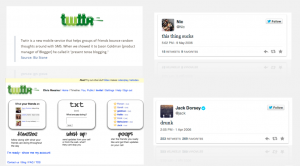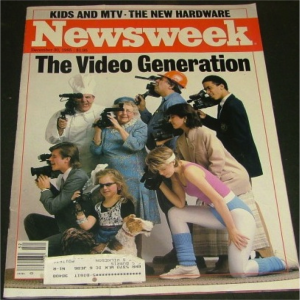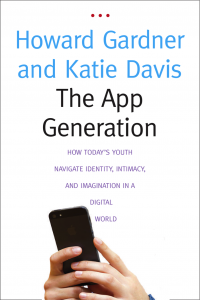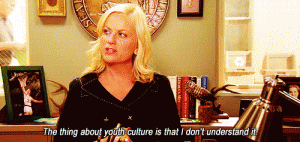I’m privileged to have been invited to speak in the opening plenary at this year’s International Communication Association conference in San Juan, Puerto Rico. The panelists were asked to speak to the question ‘Do Communication Technologies Define a ‘Generation’?’ – this is how I tackled it! Speakers’ notes and key images from the slides in-line below.
The problem with ‘generations’
I’m very pleased to note that in the title of this opening plenary, the word ‘generation’ is enclosed in inverted commas – or, as I like to call them, ‘scary bunnies’.
While I’m always more than willing to claim underdog status as a member of the perpetually overlooked and tragically misunderstood Generation X, I don’t really do demographics, let alone generations, as objects of study.
What I do know a bit about is how ideas about new communication technologies get tangled up with ideas about young people.
There is a repeated pattern here: the articulation of some novel technological formation – let’s call it ‘Technology X’ – to a generation (of ‘young people’). This group of young people is constructed as ‘the X Generation’ by the very process of that articulation; reinforcing the idea of a unified demographic that is somehow defined by the technology.
Even in my own lifetime we have seen (among others) the MTV generation, something called the Video generation;
the App generation;
and latterly, the ‘selfie generation’.
And in each case Dick Hebdige’s beautifully elegant formulation of the convergent and conflicting representations of youth culture from the 1950s onward still applies: “youth as trouble; youth as fun”. (1988, p.30).
In public and popular discourse, both new digital media technologies and their assumedly youthful users are represented as novel, creative and fun on the one hand; and risky, lawless, even downright savage on the other. You can see this pattern even in positive arguments about young people’s ‘natural’ technological prowess, such as in the early 2000s notion of the ‘digital native’ (Prensky 2001).
I’m reminded again here of Kirsten Drotner’s (1999) idea of the ‘media panic’ as an ‘intrinsic and recurrent’ feature of modernity – and while sometimes we panic about the things young people do with new media, other times we worry about what new media are doing to them. But usually, these worries say more about adult anxieties than they do about young people’s experiences, practices and understandings.
At least the ‘X Generation’ du jour, the ‘selfie generation’, is identified on the basis of cultures and practices that involve digital media technologies, rather than being entirely determined by the technology – perhaps we are getting somewhere?
On the other hand, with a phenomenon as intimate, as affective, as feminised as the selfie, moral pathology can’t be far away.
By the way, for a high-potency dose of scholarly knowledge about the selfie as cultural practice, see the new special section of the International Journal of Communication on the subject, edited by Theresa Senft and Nancy Baym (Senft & Baym 2015).
Of course, the ‘X generation’ is a trope—a cultural tic or reflex—that tidies up a messy empirical reality, as work by communication scholars has already shown (thinking here particularly of Eszter Hargittai’s empirical work (Hargittai & Hinnant 2008; Hargittai & Litt 2012) and Kate Crawford & Penelope Robinson’s (2013) critique of digital media generations, among many others).
For example: one of the effects of ‘generational’ thinking is that anxious middle class adults can assume the experiences and practices they observe in their own kids can be extrapolated to the rest of the population. But while young people may be comparatively more involved with digital media technologies than older people, there are significant differences among younger people – differences in uses, skills and modes of participation – that can be explained by social factors. This is true even in the United States, and of course in other geographical contexts the mix of ICTs and the ways they figure in everyday life vary considerably.
From digital media generations to generations of digital media?
Having said all that, I’d like to leave the construct of demographic ‘generations’ to one side for now, and to think a bit more about the ‘communication technologies’ part of the question at hand.
In my own work, I’m interested in really trying to understand how digital media technologies and sociocultural practices co-evolve. Within that, I’m interested in whether it is possible to identify discrete historical moments marked by digital transformations with distinctive sociocultural characteristics of continuity and change.
In other words, is it useful to think about generations of digital media?
Of course, any move to periodise new media history maps dangerously well on to the endless ‘versioning’ associated with industry hype cycles (Allen 2008), but I think it’s also a necessary move. Here I draw on the recent provocations Yang & Clark (2015) make in the inaugural issue of the Social Media + Society journal, where they argue compellingly for the need to study how social media are changing over time, and in fact call for the ‘periodisation’ of even very recent digital media history.
We have to get beyond the idea of change in the digital media environment either as a seamless flow of progressive innovation – history as just ‘one thing after another’, and towards something approaching a conjunctural analysis (to invoke the late Stuart Hall, also the subject of a pre-conference earlier today).
From generations to paradigms
I want to propose we think about how digital media ‘generations’ can be mapped onto social, cultural and economic paradigms – that is, the way they work to organise our thinking and practices around, for example, ‘information’, or ‘cyberspace’, or ‘social networks’.
We might think about the ‘Web 2.0’ moment from the early to mid 2000s in these terms. Consider the academic debates that occupied us then–debates around participation and labour, and internal critiques concerning optimism and pessimism about the extent to which new media opened up control over culture and political communication to a more democratic model. These debates have since shifted somewhat as the looming figures of Facebook and the ‘filter bubble’ (Parisier 2012), big data and NSA surveillance have overshadowed such folksy ideas as ‘participatory culture’; and issues like labour conditions in the factories that produce the iPhone have cast rather a different light on arguably first-world problems like creative labour in video game fandom.
Elsewhere I have already proposed the idea of a ‘platform paradigm’ (Burgess 2014) to describe the broader structures and the ideas underpinning the current ‘social media moment’, the features of which are:
- the convergence of user created content, media consumption and social networking around a small constellation of major platforms in each market;
- more seamless usable and persistent, and therefore less open and hackable technologies from a user perspective;
- increased convergence of content, advertising and social networking functions from the platform owners’ perspective; and lately
- the ‘appification’ of social media sites and services (related to a migration to mobile).
The platform paradigm manifests in distinctive scholarly configurations as well, with the rise of Twitter hashtag studies and SNA on the one hand, and the increased need to combine ANT and software studies with cultural analysis and political economy on the other (Gillespie 2014) in order to properly account for the many levels at which “platforms”are shaping and being shaped by communication practices.
But returning to the idea of digital media generations, how might we observe the life stages of digital media platforms themselves?
In other words, what happens when platforms grow up?
Platforms grow up
To give us some clues as to what changes and how, we might observe how each new digital media phenomenon, originally associated with youth culture, fun or trouble, became legitimised as ‘real media businesses’ and mainstream consumer technologies – mundane and seemingly ubiquitous on the one hand, and widely available as platforms for global public communication on the other.
This was the case with YouTube, arguably Facebook and now with Twitter. In each case, the platform itself was cast as youthful, as disruptive, as a ‘new generation’ of media technologies; in each case, discourses of maturity emerge alongside their embedding into the grown-up worlds of big tech, big media, and big data.


How can this kind of transformation be studied? Well, through the tools and techniques of web history like media archives and the Internet Archive’s wayback machine; through oral history interviews with users on their ‘careers’; through ‘object biographies’ of key sociotechnical features – the Like button, the newsfeed on Facebook; the hashtag and ‘@reply’ function on Twitter.
Of course, new new media technologies are coming down the line, bringing the acceleration of personalisation; the shift to mobile and wearable technology; and the shift to interpersonal, image-based modes of communication.
The mobile and visual turn (and its increased entanglement with app stores and handset manufacturers) will make the platforms and apps that mediate our social lives, cultural expression and public communication, and the ways that these are changing, even more difficult to study than they already are in the context of proprietary platforms and social data market. One of the primary challenges in front of us—as a ‘generation’ of communication scholars—is a methodological one: the challenge of grappling with both continuity and change in the media technologies we use to connect with the world and each other.
References
Allen, Matthew (2012) ‘What was Web 2.0? Versions as the dominant mode of internet history.’ New Media & Society 15(2): 260-275.
Burgess, Jean (2014) ‘From ‘Broadcast yourself’ to ‘Follow your interests’: making over social media.’ International journal of cultural studies, [online first]. http://ics.sagepub.com/content/early/2014/01/13/1367877913513684.abstract
Crawford, Kate & Penelope Robinson (2013) ‘Beyond Generations and New Media.’ In Hartley, John, Jean Burgess & Axel Bruns (Eds.) A Companion to New Media Dynamics. London: Wiley-Blackwell.
Drotner, Kirsten (1999) ‘Dangerous media? Panic discourses and dilemmas of modernity.’ Paedagogica Historica 35(3): 593–619.
Gillespie, Tarleton (2014) ‘The relevance of algorithms.’ In Gillespie, T., Boczkowski, P.J. & Foot, K.A. (Eds.) Media technologies: Essays on communication, materiality, and society. Cambridge, MA: MIT Press.
Hargittai, Eszter & Amanada Hinnant (2008) ‘Digital Inequality: Differences in Young Adults’ Use of the Internet’, Communication Research 35(5): 602-21.
Hebdige, Dick (1988) Hiding in the Light: On Images and Things. London: Routledge.
Parisier, Eli (2013) The Filter Bubble: How the Personalised New Web is Changing Who We Are and How We Think. London: Penguin.
Prensky, Marc (2001) ‘Digital Natives, Digital Immigrants’. On The Horizon – The Strategic Planning Resource for Education Professionals, 9 (5), 1-6.
Senft, Theresa M. & Nancy K. Baym (2015) ‘What does the selfie say? Investigating a global phenomenon.’ International Journal of Communication 9(2015), Feature 1588–1606.
Yang, Guobin & Rosemary Clark (2015) ‘Social media and time.’ Social Media + Society 1(1): http://sms.sagepub.com/content/1/1/2056305115578144.full










